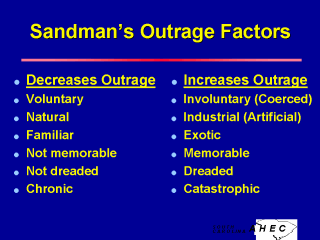| front |1 |2 |3 |4 |5 |6 |7 |8 |9 |10 |11 |12 |13 |14 |15 |16 |17 |18 |19 |20 |21 |22 |23 |24 |25 |26 |review |
 |
Sandman notes that the reaction to things that scare people and the things that kill people are often inversely proportional to the actual hazard. He has identified 20 “outrage factors.” Exercise: Ask participants to think of examples of outrage factors: e.g., Voluntary: sky diving Natural: earth quake Familiar: radon in basement Memorable:Aljar apples (media) Dreaded: cancer, Chronic: fatalities and injuries scattered and See publications on risk communication for detailed explanation. Examples: Improving dialog with communities: A Short guide for government risk communication by Caron Chess, Billie Jo Hance and Peter M. Sandman, 1988. Available from Rutgers Center for Environmental Communication. |
| front |1 |2 |3 |4 |5 |6 |7 |8 |9 |10 |11 |12 |13 |14 |15 |16 |17 |18 |19 |20 |21 |22 |23 |24 |25 |26 |review |